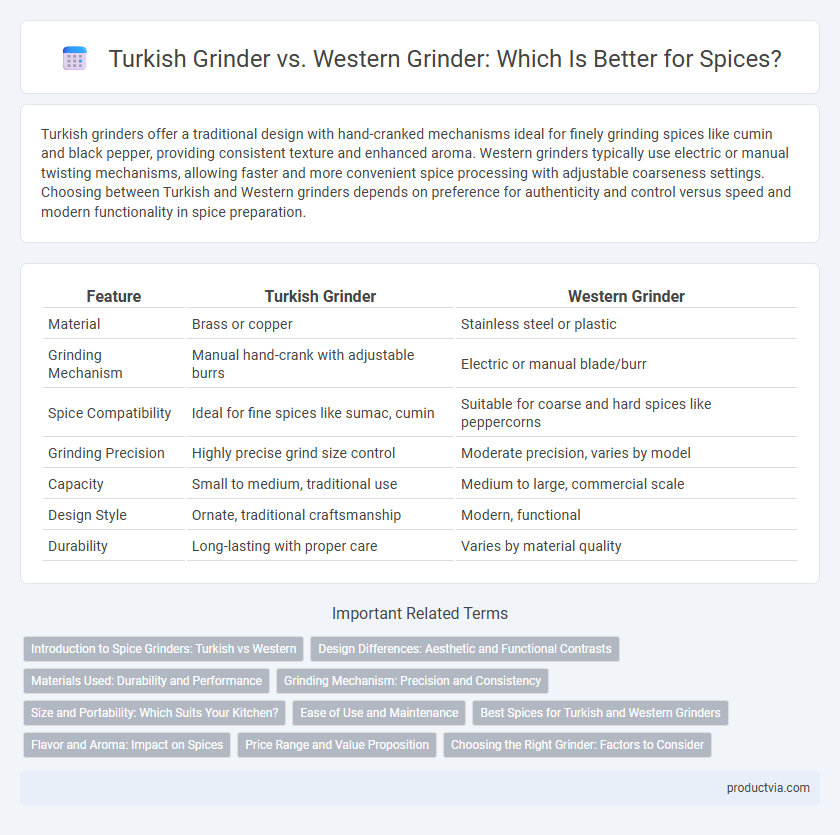Turkish grinders offer a traditional design with hand-cranked mechanisms ideal for finely grinding spices like cumin and black pepper, providing consistent texture and enhanced aroma. Western grinders typically use electric or manual twisting mechanisms, allowing faster and more convenient spice processing with adjustable coarseness settings. Choosing between Turkish and Western grinders depends on preference for authenticity and control versus speed and modern functionality in spice preparation.
Table of Comparison
| Feature | Turkish Grinder | Western Grinder |
|---|---|---|
| Material | Brass or copper | Stainless steel or plastic |
| Grinding Mechanism | Manual hand-crank with adjustable burrs | Electric or manual blade/burr |
| Spice Compatibility | Ideal for fine spices like sumac, cumin | Suitable for coarse and hard spices like peppercorns |
| Grinding Precision | Highly precise grind size control | Moderate precision, varies by model |
| Capacity | Small to medium, traditional use | Medium to large, commercial scale |
| Design Style | Ornate, traditional craftsmanship | Modern, functional |
| Durability | Long-lasting with proper care | Varies by material quality |
Introduction to Spice Grinders: Turkish vs Western
Turkish spice grinders often feature hand-cranked mechanisms with durable brass or copper materials, enhancing flavor preservation through slow, manual grinding. Western spice grinders typically use electric, high-speed blades made from stainless steel, prioritizing efficiency and convenience in spice processing. These fundamental design differences influence the texture, aroma, and freshness of ground spices, shaping culinary outcomes in Turkish and Western cuisines.
Design Differences: Aesthetic and Functional Contrasts
Turkish grinders often feature intricate hand-carved designs and brass or copper materials, emphasizing traditional craftsmanship and ornamental aesthetics, while Western grinders typically prioritize sleek, minimalist forms using stainless steel or plastic for durability and ease of use. Functionally, Turkish spice grinders utilize a rotary mechanism with coarse grinding surfaces suited for bold, textured spices, whereas Western grinders commonly employ adjustable burr or blade systems allowing precise, fine to coarse grinding depending on user preference. The contrasting designs reflect cultural priorities: Turkish grinders blend artistic heritage with robust functionality, while Western models focus on modern ergonomics and versatility.
Materials Used: Durability and Performance
Turkish grinders commonly use high-quality brass or stainless steel, offering excellent durability and resistance to corrosion, which ensures long-lasting performance in grinding spices. Western grinders often utilize materials like aluminum or plastic, providing lightweight options but sometimes compromising on durability and consistent grind quality. The choice of materials directly impacts the grinder's effectiveness in maintaining the flavor and texture of spices during use.
Grinding Mechanism: Precision and Consistency
Turkish grinders typically use a hand-cranked mechanism with ceramic or metal burrs that ensure precise grinding through adjustable settings, allowing for consistent texture control tailored for finely ground spices. Western grinders often feature electric burr or blade systems designed for efficiency and speed, though burr grinders maintain more uniform particle size distribution and consistent results. Both styles emphasize a grinding mechanism that balances precision and consistency, crucial for enhancing the flavor profiles of diverse spice blends.
Size and Portability: Which Suits Your Kitchen?
Turkish grinders are typically larger and more ornate, designed for stationary use in traditional kitchens, making them less portable but ideal for grinding larger quantities of spices with consistent texture. Western grinders prioritize compact, lightweight designs optimized for portability and convenience, fitting easily into smaller kitchen spaces or for on-the-go use. Choosing between a Turkish grinder and a Western grinder depends on available kitchen space and whether you need a tool primarily for home use or travel.
Ease of Use and Maintenance
Turkish spice grinders typically feature a manual design with intricate metal components that require regular cleaning and careful handling to maintain functionality. Western grinders often incorporate electric mechanisms with removable parts, allowing for easier use and simplified maintenance through dishwasher-safe components. Users prioritizing convenience and minimal upkeep tend to prefer Western grinders for their user-friendly operation and streamlined cleaning process.
Best Spices for Turkish and Western Grinders
Turkish grinders excel at finely grinding aromatic spices such as sumac, cumin, and Aleppo pepper, which are staples in Middle Eastern cuisine, preserving their robust flavors and essential oils. Western grinders perform best with coarse spices like black peppercorns, coriander seeds, and dried herbs, offering adjustable grind sizes suited for diverse culinary applications. Selecting the right grinder depends on the spice texture desired and the regional cooking style, ensuring optimal flavor extraction and consistency.
Flavor and Aroma: Impact on Spices
Turkish grinders, often crafted from brass or copper with ceramic burrs, preserve the essential oils in spices, enhancing both flavor and aroma compared to Western grinders which typically use stainless steel burrs that can generate more heat and slightly diminish spice potency. The slower grinding mechanism of traditional Turkish grinders ensures minimal oxidation, allowing spices like cumin and paprika to retain their vibrant taste and fragrant qualities. Western grinders focus on precision and convenience but may compromise the subtle nuances of spices' natural aromatic compounds during the grinding process.
Price Range and Value Proposition
Turkish grinders typically offer a more affordable price range, appealing to budget-conscious buyers seeking traditional craftsmanship and durability. Western grinders generally fall into a higher price bracket, emphasizing precision engineering and versatile performance for diverse spice varieties. The value proposition of Turkish grinders centers on cost-effective, long-lasting functionality, while Western models prioritize advanced features and consistency for culinary precision.
Choosing the Right Grinder: Factors to Consider
Choosing the right grinder for spices depends on factors such as grind consistency, material durability, and ease of use. Turkish grinders typically feature robust metal construction and precise grinding mechanisms ideal for coarse, even textures, while Western grinders often emphasize adjustable grind settings and ergonomic designs suited for varied spice textures. Evaluating the type of spices, desired grind size, and maintenance requirements ensures optimal performance and flavor extraction from your chosen grinder.
Turkish grinder vs Western grinder for spices Infographic

 productvia.com
productvia.com